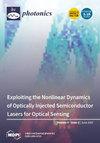Design of a Scanning Module in a Confocal Microscopic Imaging System for Live-Cell Imaging
IF 2.1
4区 物理与天体物理
Q2 OPTICS
引用次数: 0
Abstract
This study proposes a Nipkow-based pinhole disk laser scanning confocal microscopic imaging system for ordinary optical microscopy, fluorescence microscopy, and confocal microscopy imaging of biological samples in order to realize the dynamic experimental monitoring of space-based life science experiments and the fine observation of biological samples. Confocal microscopic imaging is mainly completed by a scanning module that is composed of a spinning disk and other components. The parameters of the spinning disk directly determine the quality of the image. During the design process, the resolution and signal-to-noise ratios caused by different pinhole diameters in the spinning disk are the main considerations. Changes and image blurring caused by crosstalk due to the pinhole arrangement and different pinhole spacings are addressed. The high photon efficiency of the new EMCCD (electron-multiplying charge-coupled device) and CMOS (complementary metal-oxide-semiconductor) camera reduces the exposure time as much as possible, reduces damage to living cells, and achieves high-speed confocal imaging. It is shown in a confocal imaging experiment with a variable magnification of 1–40× that the imaging resolution of the system can reach a maximum of 2592 × 1944, the spatial resolution can reach 1 μm, and the highest sampling frequency is 10 fps, thus meeting the design requirements for high-speed live-cell imaging.设计用于活细胞成像的共聚焦显微成像系统中的扫描模块
为了实现天基生命科学实验的动态监测和生物样品的精细观测,本研究提出了一种基于 Nipkow 的针孔盘激光扫描共聚焦显微成像系统,用于生物样品的普通光学显微镜、荧光显微镜和共聚焦显微镜成像。共聚焦显微成像主要由扫描模块完成,扫描模块由旋转盘和其他组件组成。旋转盘的参数直接决定了图像的质量。在设计过程中,主要考虑旋转盘上不同针孔直径所造成的分辨率和信噪比。针孔排列和不同针孔间距造成的串扰引起的变化和图像模糊也是要解决的问题。新型 EMCCD(电子倍增电荷耦合器件)和 CMOS(互补金属氧化物半导体)相机的高光子效率可最大限度地缩短曝光时间,减少对活细胞的损伤,并实现高速共焦成像。在放大倍率为 1-40 倍的共焦成像实验中表明,该系统的成像分辨率最高可达 2592 × 1944,空间分辨率可达 1 μm,最高采样频率为 10 fps,从而满足了高速活细胞成像的设计要求。
本文章由计算机程序翻译,如有差异,请以英文原文为准。
求助全文
约1分钟内获得全文
求助全文
来源期刊

Photonics
Physics and Astronomy-Instrumentation
CiteScore
2.60
自引率
20.80%
发文量
817
审稿时长
8 weeks
期刊介绍:
Photonics (ISSN 2304-6732) aims at a fast turn around time for peer-reviewing manuscripts and producing accepted articles. The online-only and open access nature of the journal will allow for a speedy and wide circulation of your research as well as review articles. We aim at establishing Photonics as a leading venue for publishing high impact fundamental research but also applications of optics and photonics. The journal particularly welcomes both theoretical (simulation) and experimental research. Our aim is to encourage scientists to publish their experimental and theoretical results in as much detail as possible. There is no restriction on the length of the papers. The full experimental details must be provided so that the results can be reproduced. Electronic files and software regarding the full details of the calculation and experimental procedure, if unable to be published in a normal way, can be deposited as supplementary material.
 求助内容:
求助内容: 应助结果提醒方式:
应助结果提醒方式:


